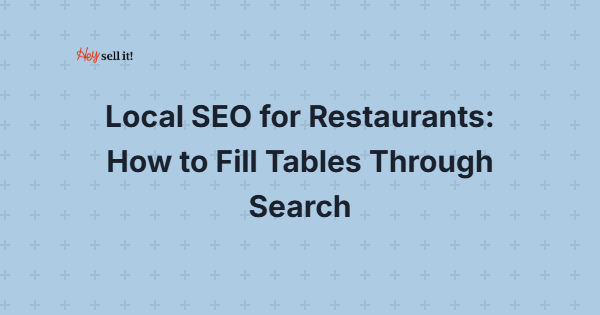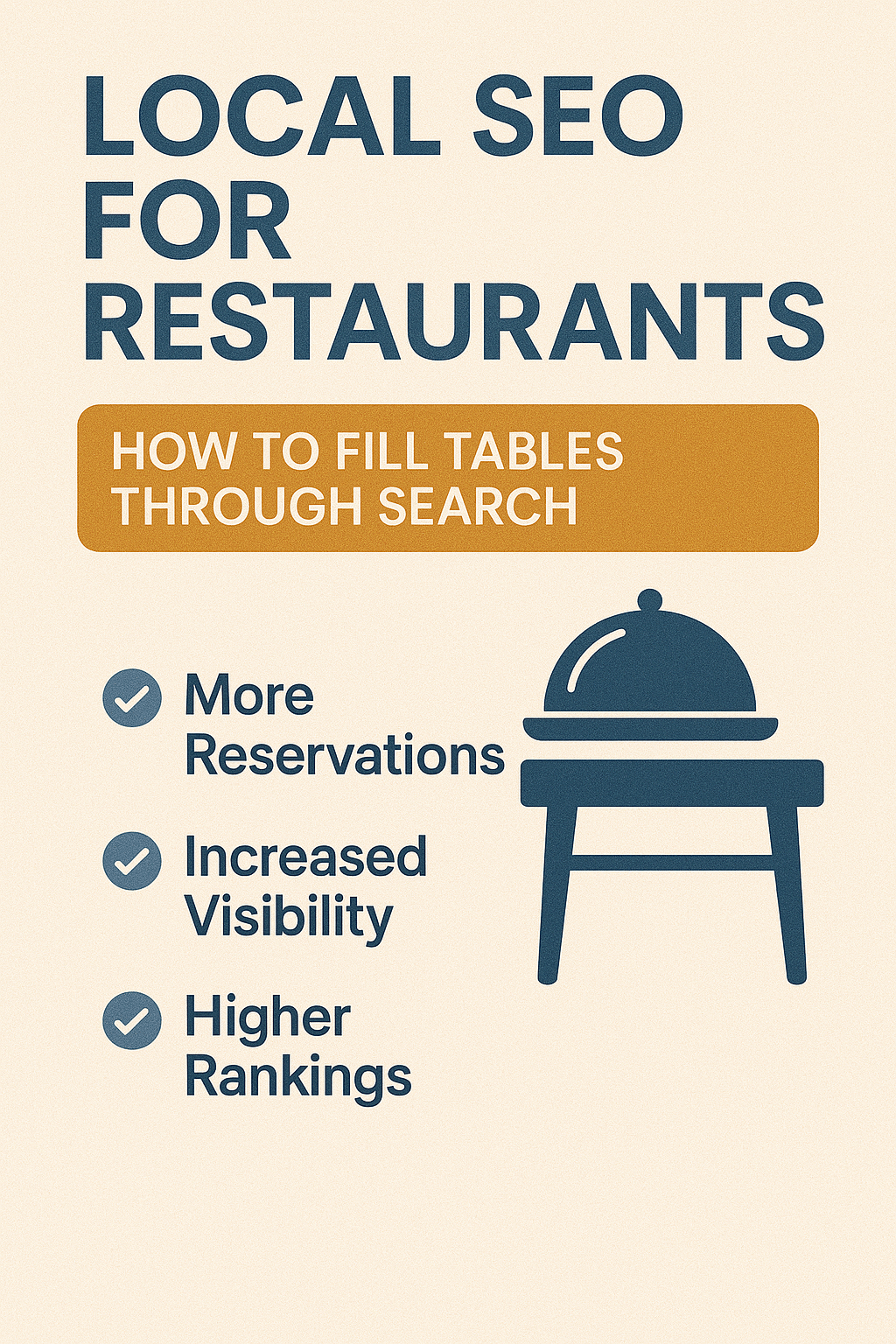Abdullah Usman
It’s 7 PM on a Friday night, and your restaurant has empty tables while your competitor down the street has a 45-minute wait. What’s the difference? Your competitor mastered local SEO, and you haven’t – yet.
In today’s digital-first world, 46% of all Google searches have local intent, and 76% of people who search for something nearby visit a business within 24 hours. For restaurants, this translates to a massive opportunity that most owners are leaving on the table. As someone who’s spent 8 years helping businesses dominate local search results, I’ve seen restaurants transform from struggling to survive into neighborhood hotspots – all through strategic local SEO implementation.
Why Local SEO Makes or Breaks Restaurant Success
The restaurant industry is brutally competitive, with over 1 million establishments in the US alone. When potential customers search for “pizza near me” or “best Italian restaurant downtown,” your visibility in those search results directly impacts your revenue. Research shows that businesses appearing in the top 3 local search results receive 70% of clicks, while those beyond the first page get virtually no traffic.
Local SEO isn’t just about being found online – it’s about being found by the right people at the right moment. When someone searches for restaurants in your area, they’re already in the decision-making phase. They’re hungry, they have money to spend, and they’re ready to choose where to dine. Your job is to make sure your restaurant appears first in their search results.
What Exactly Is Local SEO for Restaurants?
Local SEO combines traditional SEO services with location-specific optimization strategies. Unlike general ecommerce SEO that targets broad audiences, local SEO focuses on capturing customers within your geographic service area. It involves optimizing your online presence to appear prominently when people search for restaurants in your specific location.
The foundation of restaurant local SEO rests on three pillars: relevance, distance, and prominence. Google evaluates how well your business matches the search query (relevance), how close you are to the searcher (distance), and how well-known your business is both online and offline (prominence). Mastering these elements through comprehensive on page SEO and off page SEO strategies creates a powerful local search presence.
How Does Google Decide Which Restaurants to Show First?
Google’s local search algorithm considers over 200 ranking factors, but for restaurants, certain elements carry more weight. Your Google My Business profile acts as your digital storefront, influencing approximately 25% of local ranking factors. Customer reviews account for roughly 15% of ranking power, while traditional SEO factors like website optimization contribute another 30%.
The remaining factors include citation consistency across online directories, social signals, and behavioral metrics like click-through rates and time spent on your website. Understanding this breakdown helps prioritize your local SEO efforts for maximum impact. A thorough SEO audit can reveal which factors are currently working in your favor and which need immediate attention.
The Complete Google My Business Optimization Strategy
Your Google My Business (GMB) profile is your most powerful local SEO tool. Start by claiming and verifying your listing if you haven’t already – this single action can increase your local search visibility by up to 70%. Complete every section of your profile, including business hours, phone number, website URL, and detailed business description.
Upload high-quality photos regularly, as listings with photos receive 42% more requests for directions and 35% more click-throughs to websites. Include images of your restaurant’s interior, exterior, popular dishes, and staff in action. Google favors businesses that update their photos frequently, interpreting this as a sign of an active, engaged business.
Enable and utilize GMB features like Google Posts, Q&A, and messaging. Posts allow you to share updates, promotions, and events directly in search results, while the Q&A section helps you address common customer questions proactively. These features signal to Google that you’re actively managing your online presence, which positively impacts your local rankings.
Why Online Reviews Are Your Secret Weapon
Online reviews function as digital word-of-mouth marketing, influencing both search rankings and customer decisions. Restaurants with 4+ star ratings receive 28% more phone calls and 18% more website visits than those with lower ratings. More importantly, the velocity and recency of reviews matter as much as the overall rating.
Develop a systematic approach to review generation. Train your staff to ask satisfied customers for reviews at the end of their dining experience. Create review request cards with QR codes linking directly to your Google My Business page. Follow up with customers via email 24-48 hours after their visit, thanking them for dining with you and gently requesting feedback.
Respond to every review, positive and negative, within 24 hours. Your responses demonstrate customer service quality to both Google and potential customers. For negative reviews, address concerns professionally and offer to resolve issues offline. This approach shows prospective diners that you care about customer satisfaction and are willing to make things right.
What Role Does Your Website Play in Local Rankings?
Your restaurant website serves as the hub of your local SEO strategy. Implement semantic SEO principles by creating location-specific pages that naturally incorporate local keywords. For example, if you’re a pizza restaurant in downtown Austin, create content around “authentic wood-fired pizza in downtown Austin” or “best late-night pizza delivery in Austin.”
Optimize your website’s technical foundation for local search. Include your business name, address, and phone number (NAP) in the footer of every page. Create a dedicated contact page with your complete address, embedded Google Map, and clear directions. Ensure your website loads quickly on mobile devices, as 60% of local searches happen on smartphones.
Develop location-specific content that serves your community. Write blog posts about local events, seasonal menu items featuring local ingredients, or partnerships with other local businesses. This content strategy signals to Google that you’re genuinely embedded in your local community, improving your local search authority.
How to Build Local Citations That Boost Rankings
Local citations are online mentions of your restaurant’s name, address, and phone number across various directories and websites. Consistent citations across platforms like Yelp, TripAdvisor, OpenTable, and industry-specific directories strengthen your local SEO foundation. Inconsistent information across platforms can confuse Google and hurt your rankings.
Start with major citation sources like Google My Business, Yelp, Facebook, and Apple Maps. Then expand to restaurant-specific platforms like Zomato, GrubHub, and local dining guides. Ensure your NAP information is identical across all platforms – even small discrepancies like “Street” versus “St.” can impact your local search performance.
Monitor your citations regularly for accuracy and completeness. Tools like Moz Local or BrightLocal can help track citation consistency and identify opportunities for new listings. Remember that citation building is an ongoing process, not a one-time task.
Which Local Keywords Should Restaurants Target?
Effective local keyword research goes beyond obvious terms like “restaurant near me.” Analyze search patterns specific to your cuisine type, dining style, and local area. Long-tail keywords often convert better than broad terms because they capture more specific search intent.
Primary keywords might include “[cuisine type] restaurant in [city]” or “best [food type] [neighborhood].” Secondary keywords could focus on specific offerings like “outdoor dining [city],” “restaurant delivery [area],” or “family-friendly restaurants [location].” Don’t forget about voice search optimization – people often use conversational phrases like “Where can I get good sushi around here?”
Use keyword research tools to identify local search volumes and competition levels. Google Keyword Planner, SEMrush, and Ahrefs provide valuable insights into local search behavior. However, don’t rely solely on search volume – consider search intent and conversion potential when selecting target keywords.
Can Social Media Impact Your Local Search Rankings?
While social media doesn’t directly influence Google rankings, it significantly impacts local SEO through indirect factors. Active social media profiles increase brand awareness, drive website traffic, and generate online mentions – all positive signals for local search algorithms.
Focus on platforms where your target audience is most active. Instagram works exceptionally well for restaurants due to its visual nature – food photography naturally generates engagement. Facebook provides excellent local targeting options and integrates well with Google My Business. LinkedIn might be valuable if you target business lunch crowds or corporate catering.
Engage with local influencers, food bloggers, and community groups on social media. User-generated content from satisfied customers serves as social proof and can drive additional traffic to your website. Encourage customers to tag your restaurant and use location-based hashtags when sharing their dining experiences.
What Are the Most Common Local SEO Mistakes Restaurants Make?
Many restaurants sabotage their local SEO efforts through easily avoidable mistakes. Inconsistent NAP information across online platforms is the most common error, followed by neglecting Google My Business optimization. Some restaurants create multiple GMB listings thinking it will improve visibility, but this actually hurts rankings due to duplicate content issues.
Another frequent mistake is ignoring negative reviews or responding emotionally to criticism. Every negative review is an opportunity to demonstrate excellent customer service and potentially convert a dissatisfied customer into a loyal advocate. Restaurants that ignore reviews miss this opportunity and signal to Google that they’re not actively managing their online reputation.
Failing to optimize for mobile users is particularly damaging for restaurants, as most local searches happen on smartphones. Slow-loading websites, difficult-to-read menus, and hard-to-find contact information frustrate potential customers and increase bounce rates, negatively impacting local search rankings.
How to Measure Your Local SEO Success
Track key performance indicators that directly relate to your business goals. Google My Business insights provide valuable data on how customers find your listing, what actions they take, and how your visibility changes over time. Monitor metrics like discovery searches (how often your business appears in search results), direct searches (people searching for your business specifically), and actions taken (website visits, phone calls, direction requests).
Website analytics reveal how local SEO efforts translate into online behavior. Track organic search traffic, local keyword rankings, and conversion rates from organic search visitors. Set up Google Analytics goals to measure specific actions like menu downloads, reservation requests, or online ordering.
Review your local search rankings monthly for target keywords. Use tools like Google Search Console to monitor your website’s performance in local search results. Track citation consistency across major platforms and monitor online review velocity and average ratings.
Action Steps to Implement Today
Start with a comprehensive SEO audit of your current local search presence. Claim and optimize your Google My Business listing, ensuring all information is accurate and complete. Upload high-quality photos and begin posting regular updates about your restaurant.
Develop a review generation strategy and implement it immediately. Train staff to request reviews from satisfied customers and create a system for responding to all reviews promptly. Audit your website for mobile optimization and local keyword opportunities.
Build citations on major platforms and restaurant-specific directories. Ensure NAP consistency across all listings and begin creating location-specific content for your website. Monitor your progress through Google My Business insights and website analytics.
Local SEO for restaurants isn’t about quick fixes or shortcuts – it’s about building a sustainable online presence that consistently attracts local customers. By implementing these strategies systematically and monitoring your progress regularly, you’ll transform your restaurant from a hidden gem into a local search powerhouse. The investment in local SEO pays dividends through increased foot traffic, higher average order values, and stronger community connections that keep customers coming back.
Remember, local SEO is an ongoing process that requires consistent effort and adaptation to algorithm changes. Start with the fundamentals, measure your progress, and gradually expand your strategy as you see results. Your future customers are searching for restaurants like yours right now – make sure they find you first.


